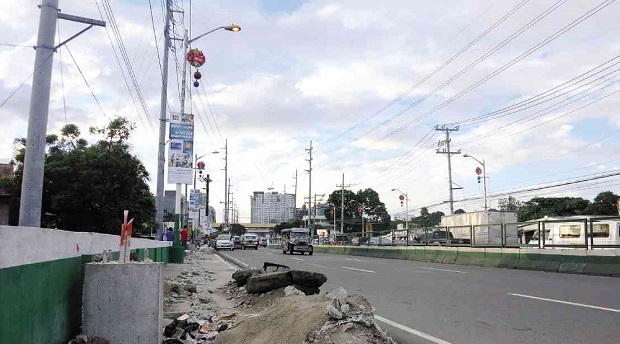
THE STREETLIGHTS on Alabang-Zapote Road in Muntinlupa are set to be replaced just four years after they were installed. JAYMEE GAMIL
A group monitoring public works spending is questioning an ongoing streetlighting project on Alabang-Zapote Road in Muntinlupa City, calling it an“overkill” and worth a closer look by state auditors and graft investigators.
The Citizens Infrastructure Integrity Watchdog (Infrawatch) noted that, since September, concrete bases for lampposts had been constructed right next to existing streetlights along a stretch of the road from Madrigal Business Park to Filinvest City.
A signboard indicates that the project has been approved by the Road Board of the Philippines and is being implemented by the Las Piñas-Muntinlupa district engineering office of the Department of Public Works and Highways (DPWH), with Hi-Tri Development Corp. as contractor, to the tune of P15 million.
INFRAWATCH says these steel bars are too thick and too costly to be used just for the base of streetlights. RICARDO RAMOS/CONTRIBUTOR
A work permit issued to the contractor in February by the previous city administration showed that 125 units of 140-watt LED lamps would be installed along a section of the road covering a distance of almost a kilometer, the Inquirer learned.
“The main issue here is that it is unnecessary,” said Infrawatch executive director Ricardo Ramos, noting that the new posts were being installed side-by-side with an existing row of streetlights put up by the local government only three to four years ago.
Ramos said he also found “overspecs” or components that seemed too big or too costly for the project, apparently “to make the contract more expensive.”
The footings and steel bars being used, for example, “are big enough to form foundations for three- to four-story buildings.” The sizes of the steel bars he saw were also “inconsistent.”
Streetlights are usually installed at least 50 meters apart, he said, but in the Alabang-Zapote project the spacing would be 15 meters or even less.
Told of Infrawatch’s observations, a City Hall official explained that the new DPWH lampposts would actually replace the ones erected by the city government.
“These are LED lights which could cut our electricity consumption by 60 to 70 percent,” city engineer Emma Cahinhinan told the Inquirer in a phone interview.
The old lampposts would eventually be removed and reinstalled on other roads in Muntinlupa, she said.
The work permit for the DPWH project was renewed by the new administration under Mayor Jimmy Fresnedi in September, since it was considered “advantageous to the city,” Cahinhinan added.
But Ramos argued that the city engineer’s explanation did not address another question: Why replace and remove the old lampposts when you can simply change the light bulbs?
In an interview, DPWH-Metro Manila subdistrict engineer Magrara Dimalawang said it was actually the previous city administration under Mayor Aldrin San Pedro that requested new streetlights from the Road Board.
He said San Pedro originally wanted lighting for local roads, but the Road Board explained that it could assist in the improvement of national roads only. The resulting agreement led to the Alabang-Zapote project.
Like Cahinhinan, Dimalawang said the existing lampposts would be “recycled” and transferred to other roads needing additional lighting.
“The city didn’t need to allocate a budget for it. The funds came from the Road Board.”
Dimalawang declined to comment on the alleged “overspecs” pointed out by Ramos, saying his office was only the project’s implementing agency and that it was the Road Board and its private consultant that designed the new posts.